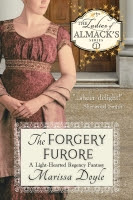More and more adults are turning to online dating sites to
find their true love. According to the Pew Research Center, which studies the
internet and technology (among other things), usage among 18 to 24 year olds
has tripled since 2013, and usage among 55 to 64 year olds has doubled. But
the internet is only the most recent way lonely hearts have advertised for
companions. In the nineteenth century, one was more likely to purchase an
advertisement in a newspaper.
Both in England and the U.S., “matrimonial” newspapers
served as matchmakers between men and women looking to marry. A publication
called “Wedding Bells” was published regularly out of Boston, and other such
publications were hawked in England. Unfortunately, there is little evidence as
to the efficacy of these ads. How many respondents actually found true love and
lived happily ever after?
Certainly, there were concerns about the practice. For one
thing, more sophisticated ladies and gentlemen did not feel comfortable having
their information bandied about in “common” publications. Many readers turned
to more genteel journals. In 1876, the Phrenological
Journal and Life Illustrated, which compiled insights into science,
literature, “and general intelligence,” received a sufficient number of queries
about offering space for matrimonial ads that the editors decided to open a
column. The ads would feature no more than 6 entries per issue, listing
qualifications of the person seeking marriage and qualifications wished for in
the partner for the hefty fee of $25.00 (equivalent to more than $500 today).
In 1839, Walks and
Wanderings in the World of Literature, a high-brow London paper, decried
the advertisements, claiming the men were only looking for a lady with money.
The editors suggested that a group of women should band together to trick these
fellows into the open, then tar and feather them and let them out into the
streets, “to be barked at by dogs, pelted by the boys, and laughed at by all.”
Ouch!
If you’d like to read some of these announcements and an
excellent commentary on them, try the now-defunct blog Advertising for Love, which
was part of the research for a doctoral thesis project.






No comments:
Post a Comment